Balkinization
an unanticipated consequence of
Jack M. Balkin
Balkinization Symposiums: A Continuing List
E-mail:
Jack Balkin:
jackbalkin at yahoo.com
Bruce Ackerman
bruce.ackerman at yale.edu
Ian Ayres
ian.ayres at yale.edu
Corey Brettschneider
corey_brettschneider at brown.edu
Mary Dudziak
mary.l.dudziak at emory.edu
Joey Fishkin
joey.fishkin at gmail.com
Heather Gerken heather.gerken at yale.edu
Abbe Gluck abbe.gluck at yale.edu
Mark Graber
mgraber at law.umaryland.edu
Stephen Griffin
sgriffin at tulane.edu
Jonathan Hafetz
jonathan.hafetz at shu.edu
Jeremy Kessler
jkessler at law.columbia.edu
Andrew Koppelman
akoppelman at law.northwestern.edu
Marty Lederman
msl46 at law.georgetown.edu
Sanford Levinson
slevinson at law.utexas.edu
David Luban
david.luban at gmail.com
Gerard Magliocca
gmaglioc at iupui.edu
Jason Mazzone
mazzonej at illinois.edu
Linda McClain
lmcclain at bu.edu
John Mikhail
mikhail at law.georgetown.edu
Frank Pasquale
pasquale.frank at gmail.com
Nate Persily
npersily at gmail.com
Michael Stokes Paulsen
michaelstokespaulsen at gmail.com
Deborah Pearlstein
dpearlst at yu.edu
Rick Pildes
rick.pildes at nyu.edu
David Pozen
dpozen at law.columbia.edu
Richard Primus
raprimus at umich.edu
K. Sabeel Rahmansabeel.rahman at brooklaw.edu
Alice Ristroph
alice.ristroph at shu.edu
Neil Siegel
siegel at law.duke.edu
David Super
david.super at law.georgetown.edu
Brian Tamanaha
btamanaha at wulaw.wustl.edu
Nelson Tebbe
nelson.tebbe at brooklaw.edu
Mark Tushnet
mtushnet at law.harvard.edu
Adam Winkler
winkler at ucla.edu
Compendium of posts on Hobby Lobby and related cases
The Anti-Torture Memos: Balkinization Posts on Torture, Interrogation, Detention, War Powers, and OLC
The Anti-Torture Memos (arranged by topic)
Recent Posts
Why the 2008 Election Matters for Reproductive Rights
Just A Few Blogs
ACS Blog
Alas, a Blog
Althouse
Arts and Letters Daily
Atrios (Eschaton)
Bill of Health
Buzzflash.com
Buzz Machine
Cato at Liberty
Juan Cole (Informed Comment)
Concurring Opinions
The Constitution in 2020
Corrente
Crooked Timber
Daily Howler
Daily Kos
Dana Boyd
Brad DeLong
Digby (Hullabaloo)
Discriminations
Daniel Drezner
Kevin Drum (Mother Jones)
Electrolite
En Banc
Eunomia (Daniel Larison)
Fafblog
Michael Froomkin (Discourse.net)
GovLab (Beth Noveck)
Rick Hasen (Election Law)
History News Network
How Appealing
Ignatz (Sam Heldman)
The Importance of (Ernie Miller)
Infolaw
Instapundit
International Economic Law and Policy Blog
IntLawGrrls
Jacob Levy
Jesus' General
Jurisdynamics
The Kitchen Cabinet
Mark Kleiman
Law Blog Central
Larry Lessig
Lawyers, Guns and Money
Liberal Oasis
Brian Leiter's Law School Reports
The Leiter Reports
Marginal Revolution
Megan McArdle
Memeorandum
Metafilter
Mirror of Justice
The New Republic
Newseum
No More Mister Nice Blog
Brendan Nyhan
Opinio Juris
Orcinus
The Originalism Blog
Pandagon
Passport (Foreign Policy)
Overcoming Bias
Political Animal (Washington Monthly)
Political Theory Daily Review
Political Wire (Taegan Goddard)
The Poor Man
Virginia Postrel
Prawfsblawg
Public Reason
Jonathan Rauch
Raw Story
Redstate
ReligiousLeftLaw.com
Reporters Committee For Freedom of the Press
Reproductive Rights Blog
Rothman's Roadmap to the Right of Publicity
SCOTUS Blog
Seeing the Forest
Clay Shirky
The Shifted Librarian
The Situationist
Larry Solum (Legal Theory)
Andrew Sullivan
Talking Points Memo
Talk Left
Tapped
Tbogg
TechPresident
The Paper Chase (Jurist)
Tom Paine
Tom Tomorrow (This Modern World)
Eve Tushnet
Uggabugga
University of Chicago Law School Faculty Blog
Unqualified Offerings
The Volokh Conspiracy
War and Piece (Laura Rozen)
Wampum
Oliver Willis
Wonkette
Written Description
Matthew Yglesias
Yin
Your Choice of Feeds
1. XML
powered by
2. Atom Feed
3. RSS 2.0
Why the 2008 Election Matters for Reproductive Rights
Guest Blogger
[For The Conference on The Future of Sexual And Reproductive Rights]
Dawn Johnsen
Are women’s reproductive rights meaningfully at stake in the 2008 elections? Does it matter whom we elect President? It is disturbingly common among even progressive law professors (not to mention otherwise-progressive elected officials and candidates) to argue no, it doesn’t matter (at least, not much)—and sometimes to go on and bemoan the greatly exaggerated role abortion plays in electoral politics, as well as in Supreme Court confirmation battles.
Professor Neal Devins—whose insightful writings on reproductive rights I have admired over the years—offers one such perspective in his post in this series:[T]he abortion battles of today bear no meaningful resemblance to 1987-1992 era battles. Today's abortion battles principally concern laws demanding that women see an ultrasound before terminating a pregnancy. While these laws (part of an effort to focus on the mental health consequences of abortion) are important, there is little reason to think that they will trigger a significant wave of far-ranging abortion regulation. Likewise, the Supreme Court will not reignite the abortion fires. Republican Supreme Court appointees will not cast the critical votes to overturn Roe; Democratic appointees will not seek to restore Roe's stringent trimester test. Put another way: The 2008 elections will do very little to change the face of abortion rights. The Casey undue burden standard will continue to govern judicial review of abortion rights. And since the states are unlikely to enact significant new restrictions on abortion, it is of only limited significance that the judicial appointees of John McCain and Barack Obama are likely to differ in their applications of Casey.
Even before reading this post, I was contemplating writing about the significance of abortion restrictions in politics and in practice, and what I’ll say here is not all or even primarily aimed at Neal’s post. Neal, in fact, acknowledges some of what I will describe. But the way Neal framed his comments—“no meaningful resemblance to 1987-1992 era battles”—struck a deep cord. Those are the very years I served as legal director of NARAL Pro-Choice America, on the front lines of what Neal describes as “hugely consequential” abortion battles. Clearly current times differ from that earlier period in some relevant ways, but I strongly disagree with his assessment of what those differences are.
What I find by far the most striking change is the degree to which the public (and even progressive opinion elites writing on these issues) fail to appreciate just how very much is at stake. That, and the remarkable success of abortion opponents in stigmatizing abortion and the women who choose to terminate a pregnancy—causing shame and harm to women and undercutting all manner of efforts to protect choice. Even as some judges, legislators, and executive officials contribute to this stigma through their exercise of governmental power, they predictably will be affected and further emboldened to the extent people increasingly are unwilling even to speak the word abortion.
The only possible way I see of making the 2008 election look insignificant is to focus the issue narrowly and exclusively on whether the outcome of whom we elect President will affect whether the Supreme Court will overrule Roe v. Wade. I’ll return to that question, but first: Presidents of course possess the authority to do far more to affect reproductive health and liberty than just appoint judges.
A few brief examples: On the New York Times’ op-ed page last Friday Senator Hillary Clinton and Planned Parenthood President Cecile Richards describe the harm that would result from the Bush administration’s proposed regulations to govern family planning providers. The regulations would force federally funded health care providers to allow employees to refuse to aid in providing any treatment to which they object. The regulations do not address how the health needs of patients are to be met in the face of such refusals.
The regulations clearly are driven by opposition to abortion, but go far beyond. Decades-old laws already allow doctors to refuse to perform abortions. Under this new rule, Planned Parenthood, it seems, couldn’t require any of its employees to provide services that are its very reason for existence. An earlier draft defined abortion to include birth control pills, IUD’s and emergency contraception; after an outcry it now leaves abortion undefined, but leaves it to the individual employee to define it broadly and incorrectly. If (as seems likely) this rule is implemented before the end of the Bush administration, the next President would have the authority to initiate the process necessary to lift it.
In fact, both Presidents Bill Clinton and George W. Bush within their first days in office issued several presidential directives on issues of abortion and reproductive health. To mention just one: Clinton lifted the Mexico City Policy/International Gag Rule imposed under the Reagan and Bush administrations. George W. Bush reinstated it, thereby denying women and men around the world access to services for pregnancy prevention and sexually transmitted diseases—including in countries with extremely high maternal mortality and AIDS transmission rates, to widespread and tragic effect.
Presidents also help determine whether government money will fund anti-abortion “crisis pregnancy centers” and whether schools will provide comprehensive sexuality education, aimed at preventing pregnancy and sexually transmitted diseases, or only teach abstinence. Also, the level of funding for pregnancy prevention programs, which of course directly affect the level of need for abortion. The Title X family planning program is funded in FY 2008 at $300 million; but if funding had kept up with medical inflation since 1980, that figure would have been $759 million. (Public money spent on family planning actually saves the government several times the amount invested, in pregnancy-related Medicaid expenses.) How Presidents themselves talk about issues of reproductive health and liberty also can greatly affect the Nation’s legal, political and cultural climate.
For the remainder of this post, though, I will limit myself to what is most often debated: the President’s judicial appointment role and its impact on the future of abortion in the courts. I long have believed that formulations that focus only on whether the Court will expressly overrule Roe are dangerously misguided. To the extent, however, this is one legitimate question, I am amazed at the confidence with which some commentators assert that the Court will never overrule Roe, regardless of changes in the Court’s composition.
I certainly hope they prove right. But consider the following: suppose a President McCain appoints a Justice or two to join Justices Antonin Scalia, Clarence Thomas, Samuel Alito and Chief Justice John Roberts. After several years of upholding every abortion restriction presented to them by misapplying the Casey undue burden standard and declaring in each case it need not reach the ultimate validity of Roe and Casey, they ultimately are presented with an abortion ban like the one currently on the ballot in South Dakota—one that criminalizes abortion with only extremely limited rape and health exceptions. What do those Justices do? My guess is at that point, they uphold the ban and expressly overrule Roe. More significant, though than my own prediction: I don’t see how anyone can have confidence in predicting the opposite.
My main point, though, is we should stop obsessing about that question. Here are two other questions involving the courts of far greater and more immediate concern that the 2008 election is likely to affect profoundly.
First, how would that same Court—with one more Justice appointed by an anti-choice President (or alternatively, on more Justice appointed by a pro-choice President)—rule on the array of restrictions short of bans, those already being promoted and those not yet invented, that threaten cumulatively to make abortion far less available, especially to the most vulnerable of women?
The prevailing anti-choice strategy is not to enact laws like the South Dakota ban, which is viewed as premature. It is instead to use the cumulative effect of legal restrictions and extralegal pressures to make states just as effectively “abortion free” as if the Court allowed the criminalization of abortion. No need to ban abortion if no one can or will perform them. Whatever the cause of the lack of legal services, the women who suffer most are those unable to travel to the nearest provider, due to location, poverty, age, domestic violence, or other life challenges.
A compelling documentary by Frontline chronicles this strategy and especially its implementation in Mississippi, one of three states already just one clinic away from “abortion free.” South Dakota, another of those states, not only is pursuing the criminal abortion ban, but also this incremental and cumulative strategy, as Robert Post describes in his post. (North Dakota is the third state down to one provider.)
How would a slightly changed Court rule on the constitutionality of the following bill almost enacted in 2006 in my state of Indiana? This bill falls in the category of what supporters of legal abortion call a “TRAP” law, for “targeted regulation of abortion providers:” laws that target abortion clinics for onerous, expensive, and medically unnecessary regulations that are promoted by abortion opponents but packaged as medical regulations. The Indiana bill would have imposed detailed and medically unnecessary physical plant requirements on abortion providers—everything from hallway size to doorway widths to placement of drinking fountains and bathrooms—effectively to require the building of mini-hospitals.
The bill would have shut down all of Indiana’s 9 clinics that perform abortions, located in only 5 of the state’s 92 counties. 97 percent of the abortions they perform are first-trimester abortions. Moreover, these are clinics that devote the overwhelming majority of their resources to preventing unintended pregnancy (therefore decreasing the need for abortion) and preventing and treating sexually transmitted diseases and other reproductive health problems. More than 90 percent of the services Planned Parenthood of Indiana provides are unrelated to abortion.
Both houses of the Indiana legislature actually passed the bill. It was stopped only thanks to a vigorous campaign led by Planned Parenthood of Indiana and the extraordinary actions of Democratic legislators. Today, abortion opponents in Indiana are working county-by-county to close down those same clinics, through ordinances that again are medically unnecessary but reasonable-sounding and that this time would require doctors at those clinics to have admitting privileges at the local hospital.
One of the central flaws, of course, with the Casey undue burden test is that whether or not a court will recognize these or any particular abortion restrictions as an undue burden depends tremendously on the identity of the judge making the determination. Who can doubt that Obama’s judicial appointees would differ in this regard from McCain appointees. (See again post by Robert Post.)
A second, more complex judicial issue at stake in the election, beyond how the federal courts will rule: Will federal judges contribute to the growing social stigma and demeaning of women through their judicial opinions and in particular, how they talk about abortion?
As bad as things looked in that critical 1987-1992 period, I never imagined that a majority of Justices on the Supreme Court would join an opinion that included some of the language contained in the Court’s 2007 Carhart decision. I was astounded when I read the Court proclaim it “self-evident” and “unexceptionable” to assume that allowing women the choice of abortion would cause some women mental harm, including “severe depression and loss of esteem,” because “[r]espect for human life finds an ultimate expression in the bond of love the mother has for her child.”
Reva Siegel, who has studied this abortion-harms-women argument in great depth, including its use in the South Dakota effort to outlaw abortion, described the Carhart majority opinion as “beyond Alice in Wonderland: criminalize abortion to protect women.” New York Times Supreme Court reporter Linda Greenhouse wrote the opinion suggested “a pregnant woman who chooses abortion falls away from true womanhood.”
The Court’s willingness, against evidence cited by the dissent, to endorse what the dissent describes as an “anti-abortion shibboleth” of course thrilled the anti-abortion advocacy community, which now can (and repeatedly does) cite the Court in its efforts to criminalize abortion on the theory women have to be protected from their own decisions. And it contributes to broader efforts to stigmatize abortion and use both law and non-legal sources to pressure women to fulfill what is seen as their natural, traditional role.
Whether future federal judges will participate in the exercise of governmental power to stigmatize abortion and women and promote traditional gender roles will depend at least in part on who appoints those judges.
I will end with a very general but to me fundamental point. Our Nation’s laws and attitudes about abortion and reproductive decisions have been central to substantial changes in women’s lives during my own lifetime. The affirmation of the importance to women of controlling their own reproductive path—when and whether to have children to raise and love—has supported the full and equal participation of women in our Nation’s affairs: in business, politics, and community life, as well as in the home. The Supreme Court has acknowledged this fact. I have no doubt that our next choice of a President can indeed significantly alter this central reality for women. Recent years already have to a degree. So I must strenuously affirm that the choice of President matters greatly, for women of childbearing years and for future generations of women, and for all of us.
Posted
6:48 AM
by Guest Blogger [link]
Books by Balkinization Bloggers

Gerard N. Magliocca, The Actual Art of Governing: Justice Robert H. Jackson's Concurring Opinion in the Steel Seizure Case (Oxford University Press, 2025)

Linda C. McClain and Aziza Ahmed, The Routledge Companion to Gender and COVID-19 (Routledge, 2024)

David Pozen, The Constitution of the War on Drugs (Oxford University Press, 2024)

Jack M. Balkin, Memory and Authority: The Uses of History in Constitutional Interpretation (Yale University Press, 2024)
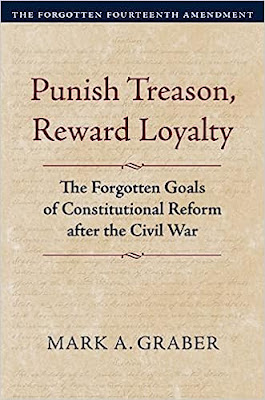
Mark A. Graber, Punish Treason, Reward Loyalty: The Forgotten Goals of Constitutional Reform after the Civil War (University of Kansas Press, 2023)
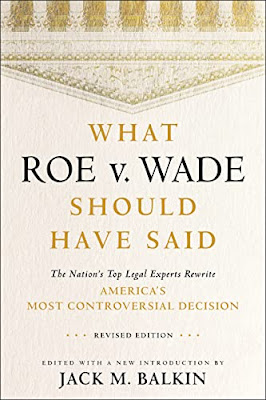
Jack M. Balkin, What Roe v. Wade Should Have Said: The Nation's Top Legal Experts Rewrite America's Most Controversial Decision - Revised Edition (NYU Press, 2023)

Andrew Koppelman, Burning Down the House: How Libertarian Philosophy Was Corrupted by Delusion and Greed (St. Martin’s Press, 2022)

Gerard N. Magliocca, Washington's Heir: The Life of Justice Bushrod Washington (Oxford University Press, 2022)
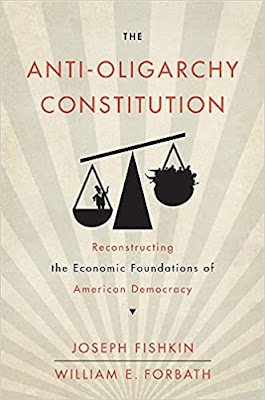
Joseph Fishkin and William E. Forbath, The Anti-Oligarchy Constitution: Reconstructing the Economic Foundations of American Democracy (Harvard University Press, 2022)
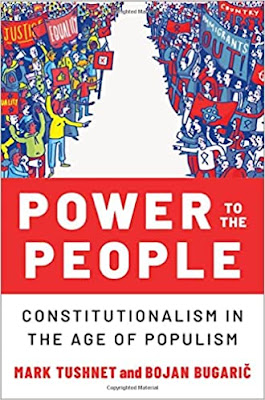
Mark Tushnet and Bojan Bugaric, Power to the People: Constitutionalism in the Age of Populism (Oxford University Press 2021).

Mark Philip Bradley and Mary L. Dudziak, eds., Making the Forever War: Marilyn B. Young on the Culture and Politics of American Militarism Culture and Politics in the Cold War and Beyond (University of Massachusetts Press, 2021).

Jack M. Balkin, What Obergefell v. Hodges Should Have Said: The Nation's Top Legal Experts Rewrite America's Same-Sex Marriage Decision (Yale University Press, 2020)

Frank Pasquale, New Laws of Robotics: Defending Human Expertise in the Age of AI (Belknap Press, 2020)

Jack M. Balkin, The Cycles of Constitutional Time (Oxford University Press, 2020)

Mark Tushnet, Taking Back the Constitution: Activist Judges and the Next Age of American Law (Yale University Press 2020).

Andrew Koppelman, Gay Rights vs. Religious Liberty?: The Unnecessary Conflict (Oxford University Press, 2020)

Ezekiel J Emanuel and Abbe R. Gluck, The Trillion Dollar Revolution: How the Affordable Care Act Transformed Politics, Law, and Health Care in America (PublicAffairs, 2020)

Linda C. McClain, Who's the Bigot?: Learning from Conflicts over Marriage and Civil Rights Law (Oxford University Press, 2020)
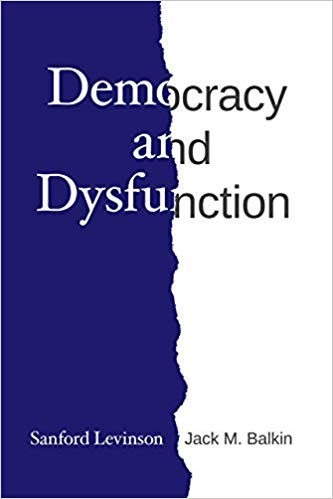
Sanford Levinson and Jack M. Balkin, Democracy and Dysfunction (University of Chicago Press, 2019)

Sanford Levinson, Written in Stone: Public Monuments in Changing Societies (Duke University Press 2018)

Mark A. Graber, Sanford Levinson, and Mark Tushnet, eds., Constitutional Democracy in Crisis? (Oxford University Press 2018)

Gerard Magliocca, The Heart of the Constitution: How the Bill of Rights became the Bill of Rights (Oxford University Press, 2018)

Cynthia Levinson and Sanford Levinson, Fault Lines in the Constitution: The Framers, Their Fights, and the Flaws that Affect Us Today (Peachtree Publishers, 2017)

Brian Z. Tamanaha, A Realistic Theory of Law (Cambridge University Press 2017)

Sanford Levinson, Nullification and Secession in Modern Constitutional Thought (University Press of Kansas 2016)

Sanford Levinson, An Argument Open to All: Reading The Federalist in the 21st Century (Yale University Press 2015)

Stephen M. Griffin, Broken Trust: Dysfunctional Government and Constitutional Reform (University Press of Kansas, 2015)

Frank Pasquale, The Black Box Society: The Secret Algorithms That Control Money and Information (Harvard University Press, 2015)

Bruce Ackerman, We the People, Volume 3: The Civil Rights Revolution (Harvard University Press, 2014)
Balkinization Symposium on We the People, Volume 3: The Civil Rights Revolution

Joseph Fishkin, Bottlenecks: A New Theory of Equal Opportunity (Oxford University Press, 2014)

Mark A. Graber, A New Introduction to American Constitutionalism (Oxford University Press, 2013)

John Mikhail, Elements of Moral Cognition: Rawls' Linguistic Analogy and the Cognitive Science of Moral and Legal Judgment (Cambridge University Press, 2013)

Gerard N. Magliocca, American Founding Son: John Bingham and the Invention of the Fourteenth Amendment (New York University Press, 2013)

Stephen M. Griffin, Long Wars and the Constitution (Harvard University Press, 2013)

Andrew Koppelman, The Tough Luck Constitution and the Assault on Health Care Reform (Oxford University Press, 2013)

James E. Fleming and Linda C. McClain, Ordered Liberty: Rights, Responsibilities, and Virtues (Harvard University Press, 2013)
Balkinization Symposium on Ordered Liberty: Rights, Responsibilities, and Virtues

Andrew Koppelman, Defending American Religious Neutrality (Harvard University Press, 2013)

Brian Z. Tamanaha, Failing Law Schools (University of Chicago Press, 2012)

Sanford Levinson, Framed: America's 51 Constitutions and the Crisis of Governance (Oxford University Press, 2012)

Linda C. McClain and Joanna L. Grossman, Gender Equality: Dimensions of Women's Equal Citizenship (Cambridge University Press, 2012)

Mary Dudziak, War Time: An Idea, Its History, Its Consequences (Oxford University Press, 2012)

Jack M. Balkin, Living Originalism (Harvard University Press, 2011)

Jason Mazzone, Copyfraud and Other Abuses of Intellectual Property Law (Stanford University Press, 2011)

Richard W. Garnett and Andrew Koppelman, First Amendment Stories, (Foundation Press 2011)

Jack M. Balkin, Constitutional Redemption: Political Faith in an Unjust World (Harvard University Press, 2011)

Gerard Magliocca, The Tragedy of William Jennings Bryan: Constitutional Law and the Politics of Backlash (Yale University Press, 2011)

Bernard Harcourt, The Illusion of Free Markets: Punishment and the Myth of Natural Order (Harvard University Press, 2010)

Bruce Ackerman, The Decline and Fall of the American Republic (Harvard University Press, 2010)
Balkinization Symposium on The Decline and Fall of the American Republic

Ian Ayres. Carrots and Sticks: Unlock the Power of Incentives to Get Things Done (Bantam Books, 2010)

Mark Tushnet, Why the Constitution Matters (Yale University Press 2010)
Ian Ayres and Barry Nalebuff: Lifecycle Investing: A New, Safe, and Audacious Way to Improve the Performance of Your Retirement Portfolio (Basic Books, 2010)
.jpg)
Jack M. Balkin, The Laws of Change: I Ching and the Philosophy of Life (2d Edition, Sybil Creek Press 2009)

Brian Z. Tamanaha, Beyond the Formalist-Realist Divide: The Role of Politics in Judging (Princeton University Press 2009)
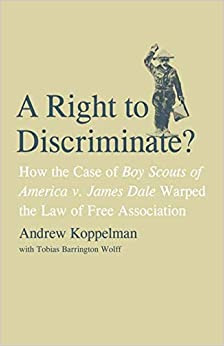
Andrew Koppelman and Tobias Barrington Wolff, A Right to Discriminate?: How the Case of Boy Scouts of America v. James Dale Warped the Law of Free Association (Yale University Press 2009)

Jack M. Balkin and Reva B. Siegel, The Constitution in 2020 (Oxford University Press 2009)
Heather K. Gerken, The Democracy Index: Why Our Election System Is Failing and How to Fix It (Princeton University Press 2009)

Mary Dudziak, Exporting American Dreams: Thurgood Marshall's African Journey (Oxford University Press 2008)

David Luban, Legal Ethics and Human Dignity (Cambridge Univ. Press 2007)

Ian Ayres, Super Crunchers: Why Thinking-By-Numbers is the New Way to be Smart (Bantam 2007)

Jack M. Balkin, James Grimmelmann, Eddan Katz, Nimrod Kozlovski, Shlomit Wagman and Tal Zarsky, eds., Cybercrime: Digital Cops in a Networked Environment (N.Y.U. Press 2007)
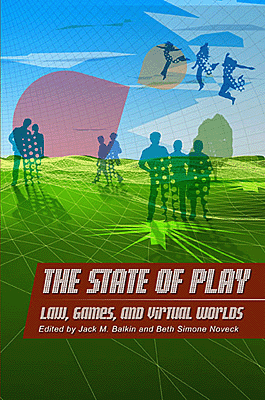
Jack M. Balkin and Beth Simone Noveck, The State of Play: Law, Games, and Virtual Worlds (N.Y.U. Press 2006)

Andrew Koppelman, Same Sex, Different States: When Same-Sex Marriages Cross State Lines (Yale University Press 2006)
Brian Tamanaha, Law as a Means to an End (Cambridge University Press 2006)
Sanford Levinson, Our Undemocratic Constitution (Oxford University Press 2006)
Mark Graber, Dred Scott and the Problem of Constitutional Evil (Cambridge University Press 2006)
Jack M. Balkin, ed., What Roe v. Wade Should Have Said (N.Y.U. Press 2005)
Sanford Levinson, ed., Torture: A Collection (Oxford University Press 2004)
Balkin.com homepage
Bibliography
Conlaw.net
Cultural Software
Writings
Opeds
The Information Society Project
BrownvBoard.com
Useful Links
Syllabi and Exams